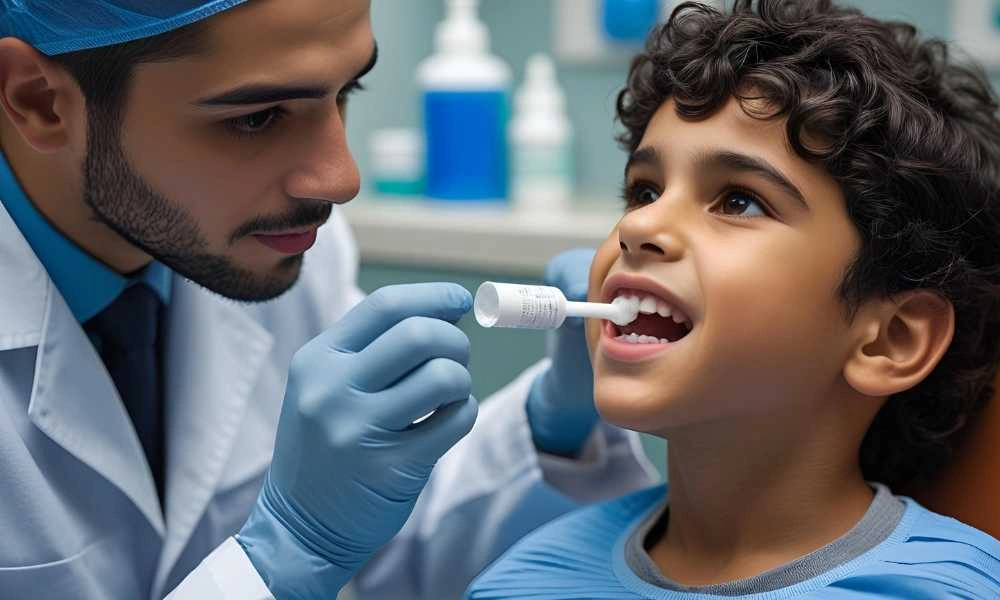
When should children’s baby and permanent teeth appear?
As a health provider, particularly in pediatrics, monitoring the developmental milestones of a child is crucial — and dental development is one of the first indications of healthy growth. Parents show up with nervous queries: “When will my baby’s first tooth come in?
This blog is your companion guide to learning about the growth of children’s teeth, from baby teeth to the permanent teeth, with some tips on good care and how your clinic can utilize digital software such as Sehat Pro to monitor it all sensibly.
Why Is Understanding Dental Milestones So Important?
All parents look forward to a magical first smile — but not many know what needs to follow it. As a medical professional, having the ability to describe tooth growth stages helps establish trust. Dental milestones not only indicate physical growth but also general health, nutrition, and oral care habits.
Sehat Pro allows for easy recording, tracking, and delineating dental timelines using digital charts. These are also used to follow up on irregularities and prepare for early treatment planning.
Stages of Teeth Development: Infancy to Adolescence
1. The First Tooth (Generally at 6 Months)
The process starts at 4–7 months. Lower central incisors tend to erupt first, then upper central incisors. Delayed teething may occur in some babies, still within normal limits.
Clinic Pro Tip: Track baby growth milestones on Sehat Pro’s chart and compare patterns of baby growth to confidently advise parents.
2. Full Set of Baby Teeth (By Age 3)
The complete set of 20 primary teeth usually comes in by age 3. They include incisors, canines, and molars.
Sehat Pro Benefit: Add dental photos, x-rays, and compare eruption patterns with built-in growth references.
3. Wiggly Teeth (Ages 6–12)
Kids typically start to lose their primary teeth around age 6, beginning with the central incisors once more. By age 12, children generally have lost all primary teeth.
Pro Tip: Sehat Pro provides the ability to record each tooth lost, track replacements, and remind for any irregularities such as early or late shedding.
4. Permanent Teeth Settle In (Ages 12–13)
This is when adult molars and canines erupt. Most children have 28 permanent teeth (excluding wisdom teeth) by age 13.
Smarts Reminder: Sehat Pro provides personalized reminders for orthodontic visits or tracking of wisdom teeth.
Oral Health Tips at Each Age
Infants (0–1 Year)
- Massage gums with soft damp cloth
- Avoid giving bottles at bedtime
- Arrange the first dental visit by age 1
With Sehat Pro: Automate appointment reminders for new visits and update records automatically.
Toddlers & Preschoolers (1–5 Years)
- Use a rice-sized amount of toothpaste
- Develop good brushing habits early
- Supervise until independent spitting
Sehat Pro Advantage: Send digital guides and videos to parents through their patient portal to support learning at home.
School-Age Children (6–12 Years)
- Use a pea-sized amount of fluoride toothpaste
- Encourage flossing and routine dental checkups
- Be watchful for grinding or sensitivity of teeth
Sehat Pro Insight: Arrange bi-annual checkups and track children’s dental behavior patterns reports.
Teenagers (13–18 Years)
- Correct alignment or crowding problems
- Encourage proper hygiene in spite of braces or retainers
- Decrease sugary foods and beverages
Pro Monitoring: Utilize Sehat Pro to track orthodontic cases, before-and-after images, and digital impressions.
Dental Issues Common Problems to Monitor
1. Pain of teething
Red, sore gums and irritability are normal. Use cold spoons or teething rings.
2. Tooth Decay in Baby Teeth
Baby teeth cavities can cause problems with adult teeth. Encourage brushing and fewer sugary snacks.
3. Over-retained Baby Teeth
Baby teeth sometimes don’t fall out on schedule, crowding new teeth. Dentists can help early.
4. Speech Issues Related to Dental Growth
Poor tooth alignment causes lisping or delayed speech.
Sehat Pro Integration: Notes and progress regarding speech and dental correlation can be recorded for easy reference to ENT experts or speech therapists.
Diet and Dental Health: Strong Connection
What your child eats speaks for their teeth. Calcium-rich diets, low-sugar foods, and hydration are the way forward.
Tip for Clinics: With Sehat Pro, create personalized diet plans for pediatric patients and link them with diet charts that change over time.
The Use of Fluoride & Sealants
Fluoride makes teeth stronger and resistant to decay. Molar sealants add an added layer of protection.
Astute Planning: Sehat Pro facilitates preventive care procedure scheduling and reminds parents of benefits through automatic notification.
How Sehat Pro Assist Dentists, Pediatricians, and Clinics?
- Digital Growth Charts
- Tooth Tracking Timeline
- Checkup Reminder System
- Photo Uploads for Visual Progress
- Patient Education Materials via Portal
- Busy Parents’ Mobile & Web Access
With the addition of Sehat Pro to your clinic’s workflow, you can communicate more effectively with parents, provide intelligent tracking, and deliver more individualized care — fostering trust and improved outcomes.
Empowering Parents Through Your Practice
Parents adore clinics that exceed scripts. Educate and empower them with visuals and reminders. Sehat Pro is more than a record-keeping system — it’s a connection between you and your patient’s daily needs.
Conclusion: Guiding a Smile for Life
From a baby’s first tooth through braces consultation, each step counts. As a healthcare provider, your influence in creating healthy habits early on is second to none. Let
Sehat Pro leverage that influence by providing you digital resources to boost engagement, precision, and outcomes.mockGet on board with your digital dental journey today. Assist your patients in creating stronger smiles — tooth by tooth — using Sehat Pro.
Frequently Asked Questions (FAQ)
Most babies start teething around 6 months of age, although it can vary between 4 to 12 months. Using Sehat Pro, you can track and log dental milestones digitally for better pediatric monitoring.
Signs include drooling, irritability, swollen gums, and chewing on objects. Sehat Pro allows clinics to send automated reminders and guides to parents on what to expect during each stage.
Regular brushing, avoiding sugary snacks, and dental checkups are key. Clinics using Sehat Pro can create custom dental care plans for pediatric patients, ensuring parents stay informed.
The first visit should be by the first birthday or within 6 months after the first tooth appears. Sehat Pro makes appointment tracking and follow-ups easy for both doctors and parents.
Yes, gaps are common and usually make space for larger permanent teeth. Sehat Pro can be used to monitor spacing and dental alignment over time to assess if orthodontic care is needed later.



